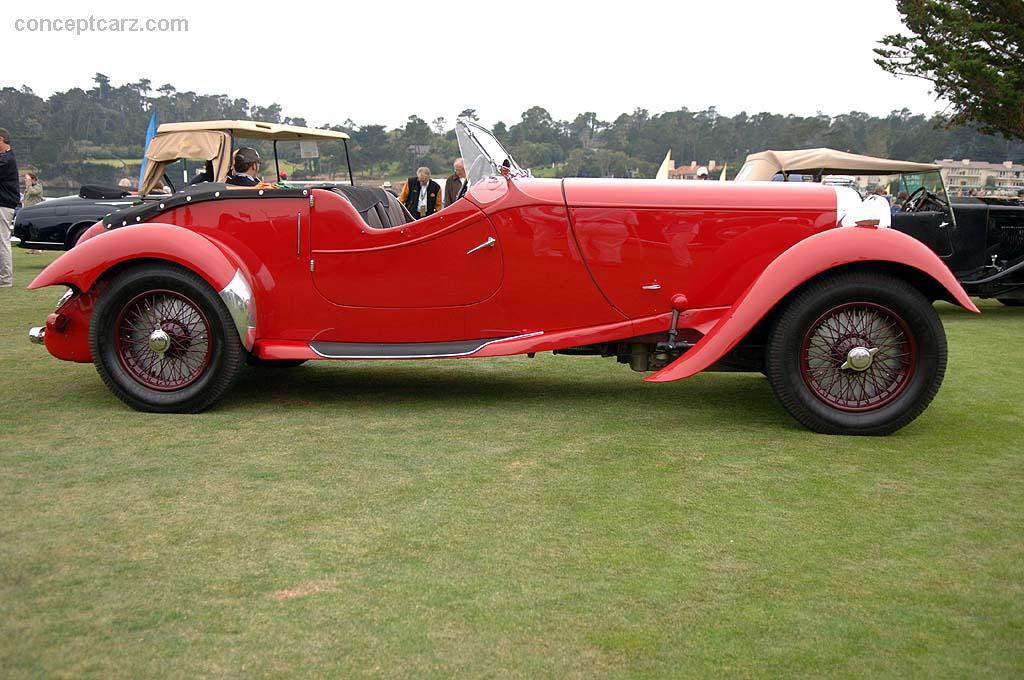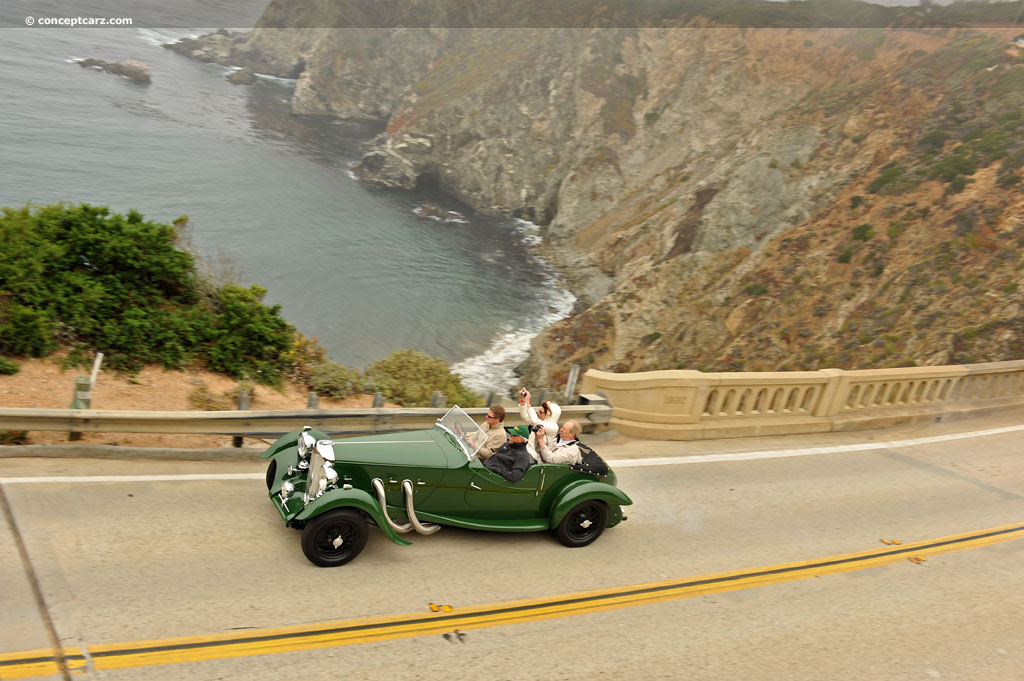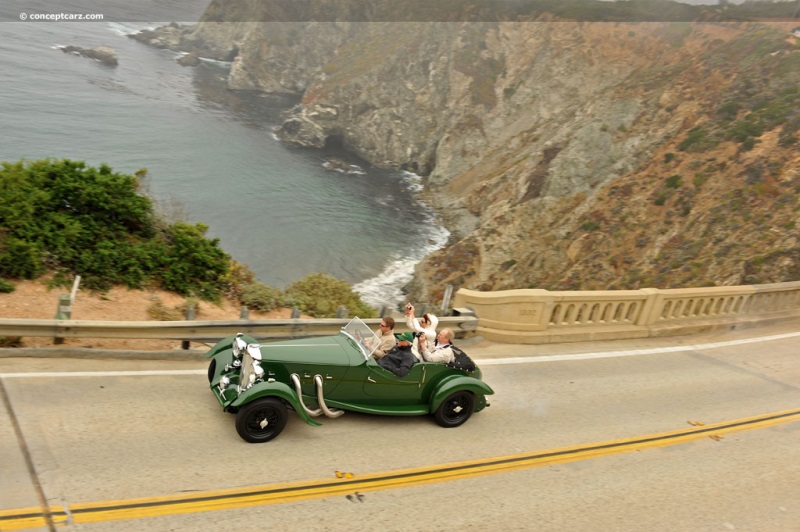1937 Lagonda LG45 Rapide Navigation
Lagonda's heritage is marked by a remarkable collection of successful sports cars, a series of significant racing achievements, culminating in a prestigious victory at Le Mans in 1935. Founded in 1906 in Staines, Middlesex, by the American Wilbur Gunn (1859-1920), who named it after a river near his hometown of Springfield, Ohio, production began with motorcycles in the garden of Gunn's house. Success was immediate, with a victory at the 1905 London to Edinburgh Trial. His first car was launched in 1907, and in 1910, its reputation was firmly established by winning the Moscow - St Petersburg Reliability Trial of 1910 with a 30hp six. The road-going vehicles it produced concentrated mainly on light cars before reverting to sporting and luxury models in the mid-1920s with the introduction of the four-cylinder, 2-liter 14/60 model. In 1929, the 14/60 was joined by the first of Lagonda's own sizes - the 3-Litre. 
RoadsterLagonda's manufacturing began a new path in 1933 when it introduced the M45 at the Olympia Show. Based on the preceding ZM 3-Litre model, it was powered by a 4.5-liter, twin-plug six-cylinder engine by Meadows. The succession of six-cylinder models that followed, including the 3.5-liter (1935), the LG45 (1936-1937), and the LG6 (1938-1940) came equipped with engines by Meadows. A team of three cars prepared by Lagonda's main agents, Fox & Nicholl, with highly tuned engines, Girling drum brakes, and short chassis, contested the 1934 RAC Tourist Trophy, finishing in fourth, fifth, and eighth place. The following year, one of these TT cars, driven by John Hindmarsh and Luis Fontes, won the 24-Hours of LeMans. These cars were the basis for the Lagonda M45 Rapide, and became even more refined with its successor, the LG45.
English engineer Walter Owen (W.O.) Bentley founded Bentley Motors Limited in London in 1919. From small premises in London, the company would quickly evolve into one of the most respected automobile manufacturers of its era, securing victories at the 24 Hours of Le Mans in 1924, 1927, 1928, 1929 and 1930. W.O.'s motto was 'To build a good car, a fast car, the best in class.'
Drophead Coupe
Chassis #: 12224
View info and history
Auction entries : 1Although successful, Bentley fell on hard times in the early 1930s and the company entered voluntary liquidation in July 1931. Bentley's arch-rival, Rolls-Royce, outbid Napier at the last minute and acquired the company. W.O. was obliged by the court to join Rolls-Royce under a contract that began in March 1932 and continued to the end of April 1935. The Lagonda M45R Rapide with a Meadows engine won the 1935 Le Mans 24-hour race on June 16, 1935 (putting an end to Alfa Romeo's four consecutive win streak). The following week, Lagonda was saved from receivership by Alan P. Good. Shortly thereafter, W.O. became part of the new Lagonda board, serving as Technical Director. He was joined by the majority of Rolls-Royce's racing department staff. Although W.O. was unable to persuade Harry Grylls to join his engineering staff, he was able to recruit Stewart Tresilian, Frank Stark, Reg Ingham, and Donald Bastow. Tresilian became the chief designer of the V12 project that was introduced in 1937. The 4,480cc engine initially produced 180 horsepower and offered top speeds in excess of 100 mph. When Tresilian left in early 1938 for a Hawker Siddeley subsidiary, the development of the V12 stalled, and progress was eventually canceled due to Lagonda's financial difficulties, prompting more staff to leave. After World War II, Lagonda was acquired by David Brown in 1947 and moved in with Aston Martin (another purchase by Mr. Brown) in Feltham, Middlesex. Production resumed with the final prototypes from Bentley, the 1948 Lagonda 2.6-Liter twin overhead camshaft straight-six engine, which became the basis for the Aston Martin engines of the 1950s.
Under W.O. Bentley's technical direction, the Lagonda LG45 gained numerous improvements over its M45 predecessor, including flexible engine mounts, synchromesh gears, and centralized chassis lubrication. The LG45 came in three versions known as 'Sanction' (improvements) 1, 2, and 3, each with more Bentley refinements. By 1938, the LG6 had gained hydraulic brakes and an independent front suspension by torsion bar.
Boattail Convertible Coupe
Chassis #: 12245/G10S
Engine #: 12245
View info and history
Auction entries : 2The 4,453cc single overhead camshaft inline six-cylinder engine with twin SU carburetors produced 120 horsepower at 3,400 RPM. Output varied depending on configuration, with 1937 models delivering upwards of 150 horsepower at 5,500 RPM. The engine was paired with a four-speed manual transmission with a single dry plate clutch, and stopping power was by four-wheel Girling hydraulic drum brakes. The chassis was suspended by semi-elliptic leaf springs, with a solid front and live rear axle. The standard wheelbase size measured 129 inches. It is believed that 278 examples of the LG45 were built, plus an additional 25 higher-specification Rapides. This was lower than the 410 M45s (plus 53 M45 R Rapdie) and the 470 Rapiers (plus 45 higher specification examples).Following the LG45, the 4,467cc six-cylinder Meadows engine powered by the LG6, which was produced from 1937 to 1940. It used the chassis of the V12 model but lengthened by 3.5 inches to accommodate the longer inline engine. Sixty-seven examples had a wheelbase size of 127 inches, and eighteen measured 135 inches.
by Daniel Vaughan | Oct 2023

Roadster
Walter Owen Bentley
English engineer Walter Owen (W.O.) Bentley founded Bentley Motors Limited in London in 1919. From small premises in London, the company would quickly evolve into one of the most respected automobile manufacturers of its era, securing victories at the 24 Hours of Le Mans in 1924, 1927, 1928, 1929 and 1930. W.O.'s motto was 'To build a good car, a fast car, the best in class.'

Drophead Coupe
Chassis #: 12224
View info and history
Auction entries : 1
The Lagonda LG45
Under W.O. Bentley's technical direction, the Lagonda LG45 gained numerous improvements over its M45 predecessor, including flexible engine mounts, synchromesh gears, and centralized chassis lubrication. The LG45 came in three versions known as 'Sanction' (improvements) 1, 2, and 3, each with more Bentley refinements. By 1938, the LG6 had gained hydraulic brakes and an independent front suspension by torsion bar.

Boattail Convertible Coupe
Chassis #: 12245/G10S
Engine #: 12245
View info and history
Auction entries : 2
by Daniel Vaughan | Oct 2023
Related Reading : Lagonda LG45 History
Wilbur Gunn was born in 1859 and grew up in Springfield, Ohio. He arrived in England in 1891, where he met Mrs. Constance Grey, his future wife. She was a widower who had lost her husband in 1896. Constance and Gunn married in 1897. In 1898 Wilbur adopted a single-cylinder petrol engine to his bicycle. Within time, the Lagonda factory would be built on the property of their house. The name Lagonda....
Continue Reading >>
Continue Reading >>
- 1937 Lagonda LG45 Rapide Menu
- Article
- Image gallery
- Valuation
- Specifications
- Profiles
- Production figures
1937 Lagonda LG45 Rapide Vehicle Profiles
Recent Vehicle Additions
Performance and Specification Comparison
LG45 Specification Comparison by Year
Year
Production
Wheelbase
Engine
Prices
Related Automotive News

World's oldest Bentley returns to the Isle of Man to celebrate team win centenary
EXP2 – the oldest Bentley in world - returns to the Isle of Man
Celebrates centenary of winning the 1922 Isle of Man TT team trophy
Joins largest display of 3-Litre Bentleys ever assembled
More than 70 historic cars on Douglas promenade
EXP2 le...

RM Sotheby's Presents Highly Original Aston Martin DB3S Works at Monterey Auction
SECOND WORKS CAR, CAMPAIGNED BY MOTORSPORT HERO PETER COLLINS
DB3S WORKS JOINS LIST OF STUNNING MODELS THROUGH THE DECADES SET FOR AN EVENING WITH ASTON MARTIN ON 15 AUGUST
RM Sothebys offers highly original and matching numbers 1953...
Sir Henry Ralph Stanley Birkin: No Christmas Tiger
Remembered as one of the most influential of the famous Bentley Boys, Henry Tim Birkin was anything but a mere member of Britains upper crust. Head-strong, courageous and unyielding, Birkin would often be challenged to mix it up with the aces...

LAGONDA ACHIEVES WORLD AUCTION RECORD PRICE OF £1.6 MILLION AT BONHAMS GOODWOOD REVIVAL
Bonhams biggest ever Goodwood Revival Sale achieves £15.4 million
Lagonda EPE 97 sets a new world record, selling at £1,569,500
1930 OM Superba achieves £1,255,900 whilst a Lot 1957 Mercedes-Benz 300SL Roadster sold above estimate at £...

Jochen Mass: The Mass-ter Breakthrough
The city of Munich, Germany is one of the leading academic cities in the world hosting numerous, and famous, universities within its limits. It would be against this backdrop, in September of 1946, that Jochen Richard Mass would be born. Fittingly, he...





































